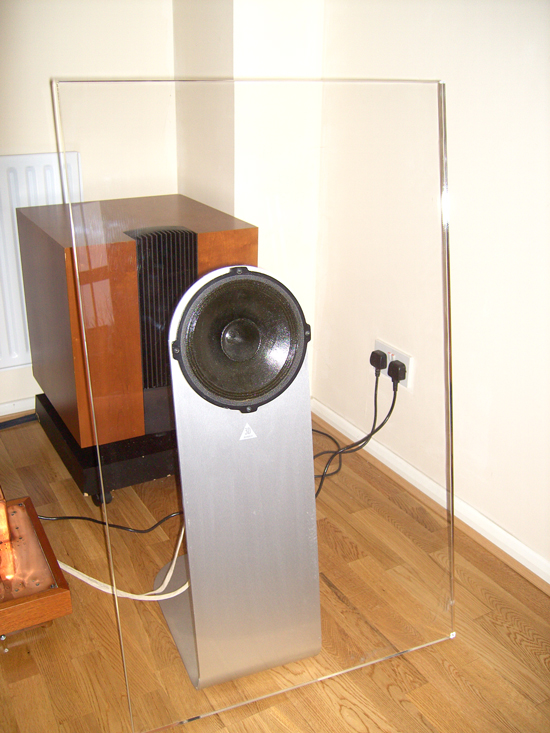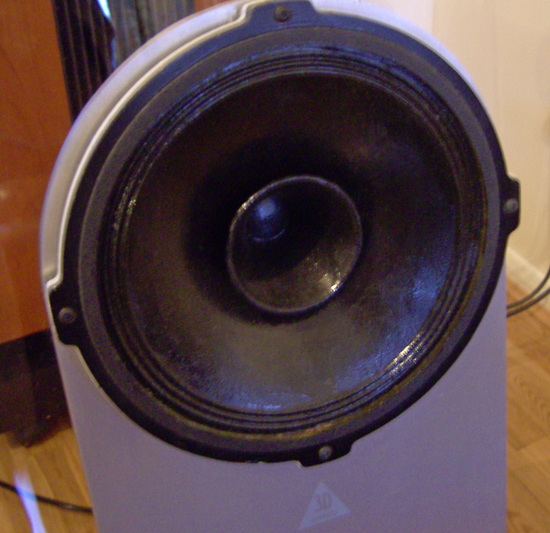The Test System
Before we go on to look at some of the PC software and hardware out there, I'll offer up a quick overview of the test system. Some of the components used really are out on a limb with price tags that are not for the faint of heart. In audiophile currency, I probably have what amounts to a mid-budget system. If your interest is in low budget products, be warned that the rest of this page will probably make your stomach churn. However, you've not been forgotten and we will add a few suggestions here and there should you have champagne tastes on beer budgets - as most of us probably do, especially in this time of credit crunch.
Speakers
 |
Real Hi-Fi owner and Supravox distributor Matthew Jameson was kind enough to provide us with a pair of test speakers based upon Supravox Signature Bicone Drivers known as the Transparence from a company called 3D Sonics. The Bicone Signature driver is a high efficiency (claimed 96dB sensitive) wide bandwidth design featuring a whizzer cone to supplement high frequency reproduction while the main cone takes care of the rest. The parameters of these drivers make them eminently suitable for an open baffle design like the Transparence.
If you keep your ear to the ground in loudspeaker circles, you'll know that open baffle loudspeakers have made a marked resurgence over the last five years or so. One of the chief perpetrators of this revival was a fellow named Throsten Loesch. Thorsten publicized his build of the Supravox Bicone Sig's using the very design that went on to become the 3D Sonics commercial venture. The remarkable simplicity was just what many in the DIY audio community were looking for: an easy to build high performance loudspeaker that could use a variety of drivers according to budget. I had the pleasure of listening to these speakers around five years ago at Thorsten's house; needless to say, it was an experience I never forgot. The absence of a walled cabinet allows the sound to fly out in all directions creating a soundstage that simply makes the loudspeaker drivers disappear.
All good things come with a slap around the cheeks and here's the part that the standard "boom 'n tizz" audio loving public won't like: the price tag is around £2400 UKP for a pair of these beauties. In audiophile markets, a price tag like this is hardly sweat inducing as there are plenty of high-end designs that cost multitudes more. If you are worried about the price, there's no reason to fret as DIY'ing a pair yourself that should get within 95% of the commercial model is not out of the question.
 3D Sonics makes an in-house change to the drivers that involves coating them with a few layers of C37 lacquer to humanize the sound. |
Stock signature Bicone drivers are available for DIY endeavors from Supravox USA, Supravox France for the EU, and direct from Real Hi-FI for the UK at around a third of the cost of the "ready to go" Transparence. If that's still too much for you, another door is open by using the budget friendly Visaton B200 driver with suitable baffle adjustments to suit its parameters.
The Transparence design is fiendishly simple: a single driver in a 6'x4' acrylic baffle that uses an aluminum L-bracket as a stand and as a means of providing additional rigidity to the baffle. There's no crossover as the driver covers the range of 50 Hz to 15 KHz on its own. That's most of the audible range covered by a single point source. While the top-end extension is enough even for super ears, the low-end obviously needs augmenting with a subwoofer for bass heavy music. For this purpose I use a Linn AV 5150 subwoofer crossed over at around 48 Hz that integrates very well with these speakers, especially when we use DRC to level some of the room response abnormalities.
Whether or not you have the financial clout to buy the fully fledged 3D Sonics Transparence, it's certainly worth investigating the sonic landscape that open baffle designs can create. The availability of drivers for just about every budget leaves the onus of their use squarely in the hands of the DIY'er. Don't pass up the chance to try them out.










114 Comments
View All Comments
Christobevii3 - Monday, December 1, 2008 - link
What about using a dts/ddl sound card to output to a basic receiver?Rajinder Gill - Monday, December 1, 2008 - link
If going to the nth degree for 2 channel it’s hard to look past USB-I2S in async. For multichannel, a DTS/DDL card is perfectly adequate. Although I’d still use an external solution if I could find one.wolrah - Monday, December 1, 2008 - link
How do you figure I2S is any better than S/PDIF? S/PDIF supports up to 20 bit resolution at either 48 or 44.1 KHz, so it can carry a CD audio stream natively. The bits on the disc are the bits flowing out the optical port on the back of your gear of choice.In theory an I2S signal will be able to take more interference, but when we're talking optical signals in a home environment the kind of interference needed to make a difference would be on the scale that you'd never be able to listen to anything.
Goty - Monday, December 1, 2008 - link
Well that's easy to answer:Nope. I'll stick with my Martin Logans, tyvm.
wolrah - Monday, December 1, 2008 - link
In fact it easily can, because plain and simple reading from the disc itself is error prone. A one time rip to WAV or [lossless format of your choice] using cdparanoia on its insane mode output through a high quality sound card will be the same as or better than any silly 4 digit CD player.Even playing straight off the disc, there's no reason to believe any "audiophile" gear will play a CD any better than any other CD player unless there's a design flaw like a crappy power supply.
On the note of power supply, am I the only one who laughed at the bit about the battery vs. the wall wart? Who wants to bet that he's never double-blind tested that one. That's the wonderful thing with A/V gear snake oil, it's very easy to hear what you want to hear.
mindless1 - Monday, December 1, 2008 - link
I've hand-built amps for years and double-blind tested batteries and wall warts. Yes there is a difference. A good (read: overkill for anyone not into building audiophile equipment) localized power filter stage, if not localized regulation, would ideally negate the difference between the two power sources but that can also unnecessarily increase the build complexity, time, and cost.PS the battery is almost always inferior assuming the wart has proper shielding or is inadequate in capacity, and generally I refer to a wart as only a transformer and rectification stage, not trying to build an entire high precision linear regulation stage inside of it due to limited space and EMI.
Rajinder Gill - Monday, December 1, 2008 - link
Martin Logan makes electrostatic loudspeakers if I recall.I'm not sure where that fits into using a PC as a transport and for DRC. Unless you're refering to the approval of open baffle design loudspeakers using te supravox drivers?plonk420 - Monday, December 1, 2008 - link
this is surreal...my $20 Chaintech AV-710 just died in the last 48 hours. i've been trying to resist the Head-Fi audiophile talk and try to find cooler heads to verify whether or not i should go X-Fi or DAC (something silly looking like the HotAudio HotUSB1 or Silverstone), or try to figure out if i'm experiencing the placebo effect "falling back upon" my ALC883, which i can swear "doesn't sound as good" EVEN THOUGH i'm fully aware of the power of placebo.
i'm not sure i liked the mixed bag of positive and negative reports on (cheap) X-Fi vs Xonar vs X-Fi USB vs some DAC vs E-Mu 0404/0202
mindless1 - Monday, December 1, 2008 - link
Choose a Creative card for gaming sound effects. Choose a DIY DAC for highest audio quality at a reasonable price. Buying some cheap commodity grade DAC is a gamble, I'm not familiar with those two products you mentioned but generally in the consumer segment and price range you end up buying an idea, a type of tech but not excellence in that execution.MOtherboard integrated audio usually doesn't sound as good including one using ALC883, though someone with poor hearing or gear may notice the difference less and less depending on where the weakest link in the chain is and how bad it is.
Gannon - Monday, December 1, 2008 - link
I have an X-Fi and it's better then my audigy, mind you I got the more expensive version with front panel and the remote. I use it for everything and have never had a problem, though I don't use vista at all just XP.